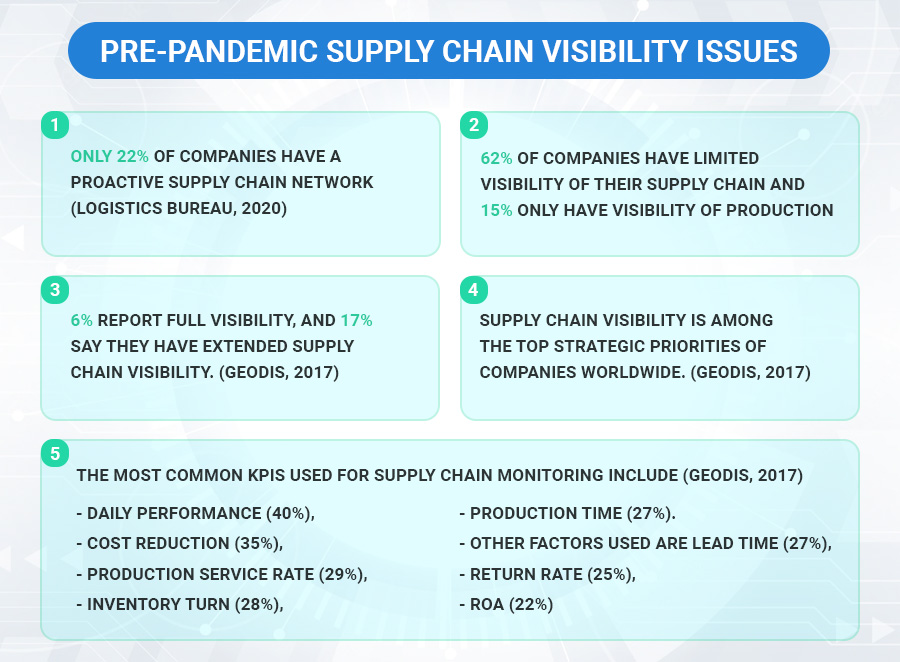Global supply networks are difficult to grasp. They are multi-tiered, multi-dimensional ecosystems made up of intricately linked components that enable agile techniques, just-in-time production, and delivery models.
According to the 2020 Supply Chain Resilience Report, the COVID-19 pandemic was the most significant and effective danger to global chains in 2020. Outnumbering previously known risks such as trade restrictions, natural disasters, and cyber warfare combined.
KEY TAKEAWAYS
- Understanding Supply Chain Resilience and its Role in Supply Chain
- How Resilience Minimizes the impact of Disruption
- Skills to create supply chain resilience
- What is Recovery Phase and How Supply Chain Return to Full Operations After Disruption
- Key Capabilities When Building Resilience
- Supply Chain Resilience Strategies
Breakdowns in the supply chain might now threaten your company's very existence. The supply chain is a complex network, and the risks it entails, such as natural disasters, accidents, economic penalties, and cyber warfare, are increasing in frequency and intensity as a result. As a result, warehouse and supply chain management resilience has never been more crucial. In another comparison, the supply chain is like a deck-of-cards pyramid. To mention a few probable possibilities, an earth tremor, transportation infrastructure collapse, fire in the manufacturing factory, global political disturbance, and now the pandemic might shake any card at the bottom, causing the entire pyramid to fall. In other words, if one component of the supply chain fails, the entire network is jeopardized.
As supply chains get more complex, the likelihood of anything going wrong and affecting the entire system rises. Traditionally, the supply chain was viewed solely as a business entity by the logistics company in India. It was far too dissimilar to today's technologically advanced supply chain, which is vital to the company's operations, dependability, and long-term success. Any disruption in the supply chain jeopardizes the organization's ability to perform this project. Supply chain resilience is the solution! According to several scholars and top academics, supply chain resilience is the capacity of a supply chain to not only withstand disturbances but also to regain operational capabilities once disruptions occur.
Japan's 2011 earthquake and tsunami provided the most famous supply chain resilience examples. Nissan quickly chose to develop a parallel supply network, which enabled them restart operations and recoup lost market share faster than Toyota. Toyota learned its lesson too by understanding the importance of resilience in the supply chain!

Vital Skills for Ensuring Better Resilience
The top talents or steps identified by Harvard Business Review to develop supply chain resilience are as follows:
Use Contemporaneous Instead of Successive Actions
Using parallel processes rather than sequential processes in important stages such as manufacturing, development, and distribution speeds up the recovery process while also improving responsiveness. By using this strategy, multinational corporations may readily swap suppliers if a certain location is struck by a natural or man-made calamity. As with the COVID-19 pandemic, a large number of nations were afflicted, including China, the United States, Germany, and even India, and the supply of everything was disrupted.
Imply Customary Processes, Don’t Go Crazy!
Standardized processes with indistinguishable elements enable organizations to move quickly by reallocating resources where they have capacity or where the demand is highest. A growing number of companies are consistently lowering risk by introducing interchangeable components into their product lines and standardizing production procedures across factories and manufacturing units.
Schedule a Postponement
Because disruption is imminent, resilience is essential. One area is the plan to postpone. This often addresses how to postpone manufacturing while still delivering to the consumer. Keeping materials in a semi-finished state offers for greater flexibility in transferring items from excess to shortage areas. It also enhances customer service while improving fill rates and lowering inventory carrying costs.
Divide strength
The corporation's willingness to react quickly will help determine success or failure during both the resistance and recovery stages of supply chain resilience. Organizations and participants must be permitted to make judgements and corrective actions as quickly as feasible and as close to the action as possible.
Sync Sourcing Strategy with Your Supplier
The current pandemic highlighted an overreliance on single supplier relationships or dealing with suppliers from a single location. It has pushed firms to consider a strategy that includes multi-source suppliers as part of the resiliency. The more, the merrier!
The supply chain's ability to reduce the consequences of disruption by either seeking to avoid it entirely or limiting the amount of time between the commencement and conclusion of the disruption's influence on the supply chain warehousing. Resistance shows how effectively a supply chain is prepared to anticipate and minimize the effects of any disruption. Recovery refers to the capacity of the supply chain to restore full operations following an interruption. The capacity to revert to consistent performance is regarded as the normalization step of supply chain resilience. Firms will frequently take time following recovery to learn from their observations in order to help in future planning and supply chain risk management strategy. Furthermore, supply chain resilience is a combination of resistance and recovery.
Strategies To Build A Resilient Supply Chain
In this last section, we'll go through the critical tactics for developing supply chain resilience, regardless of the industry you work in. Where are the redundancies and weaknesses? We must acknowledge that dangers can originate anywhere in your supply chain, and possible weaknesses may include:
- Overreliance on a single source or distributor
- Traceability and supply chain self-sufficiency have an impact on supply chain monitoring and tracing.
- Using technological digitalization or specialized advances such as artificial intelligence inefficiently (AI)
- Depending on suppliers in certain countries where costs may put existing or future trade conflicts at risk
The plan is to conduct a risk assessment to identify the most critical weak points in your supply chain. It's a different story if you offer a product that requires parts that can only be obtained from one vendor, but if not, you should be able to put measures in place to enhance resilience and decrease supply chain risk. When evaluating redundancies, try to find your limit of tolerating redundancy. Supply chains usually necessitate some redundancy, so you may raise output as needed, but not to the point where production and profit suffer.
Distribute Stock Count To Various Places
Supply chain management companies in India that distribute from a single site and close during a crisis are all aware of this problem. When everything is going well and everything is in order, having all of your inventory in one place is fine. However, company owners are aware of the destruction caused by natural catastrophes, man-made disasters, pandemics, and lockdowns. A single site strategy is neither logical nor likely to be sustainable in the long run. While we're talking about inventory distribution in terms of supply chain resilience, it may also have other advantages, such as:
- Enhancing your geographical scope
- Shipping and fulfillment times are shortening.
- Reduced shipping expenses for both your consumers and your business
- You can save money elsewhere in your supply chain if the warehouses are near to the suppliers.
- Consult with your vendors to develop trust and performance metrics.
The robustness of your supply chain is determined by the strength of your vendor relationships. If you don't communicate with your vendors and are out of sync, you expose an unacceptable portion of your supply chain to serious danger. Your vendors must understand your expectations and commit to meeting them, whether it's in terms of product lead times or guaranteeing a reliable supply chain. Agree on how you will track success toward all of these goals, and actively interact with your suppliers to help them improve.
Diversify the network
Diversifying the supply chain network is another excellent method. It protects your business against disturbance and motivates your vendor network to perform better. You may do a lot to broaden your overall supply chain network, such as ensuring that your procurement department is fully competent in multi-sourcing. If you obtain the identical item from several wholesalers, you must validate standard equality. If your supply chain is overly reliant on a single area, the likelihood of interruption increases. As a result, if near-shoring is a viable alternative, go for it. Near-shoring may increase the robustness of your supply chains by ensuring that you have regionalised solutions inside your network. Businesses in logistics and distribution are dealing with unanticipated demand that is unlikely to abate in the near future.
To ensure transit safety, employ a variety of carriers and fully leverage your shipping plan, in addition to collaborating with worldwide distributors. Utilize the expertise of local distribution professionals in both distribution and supply chain management. By dividing your shipping requirements across different vendors, you will experience less interruption and will be forced to seek a tiny remedy rather than a large one if an issue arises. Working with local companies can also assist to build trust among your customers and those in your supply chain.
Keep Buffers To Avoid Shortages
Because there is very little monopoly in the market and items are so widely available nowadays, a scarcity of supply may be the last time a buyer considers purchasing from you and going to another vendor, unless you have a unique product with your copyrights. The simplest method to establish a more robust supply chain is to keep a buffer of stock on hand. It implies that you may continue to provide consumers while fixing the flaws in the situation. While stock buffering can be difficult to explain owing to the large amount of working capital required, it is worthwhile if your company can afford to stockpile a variety of items to avoid shortages.
Conclusion
Many supply systems are relatively fragile and susceptible to disruption by catastrophic environmental, political, or economic catastrophes. A swarm of interrelated corporate developments has raised their relative susceptibility amid a moment of growing threat diversity and severity. This helps to understand 3PL management companies why supply chain management and resilience are currently such hot subjects. Over the last two decades, academics, consultants, and others have performed substantial study to better knowledge of supply chain risk profiles and resilience alternatives. Many conceptual and analytical frameworks, as well as planning tools, are now available to help firms establish risk and resilience plans. These models are based on a key trade-off between efficiency and redundancy in global supply chain management. Because of the enormous cost of supply chain disasters in the 1990s, this trade-off must now be rebalanced in favor of risk reduction and resilience.

Lovely Mehra
Corporate Communications Specialist




